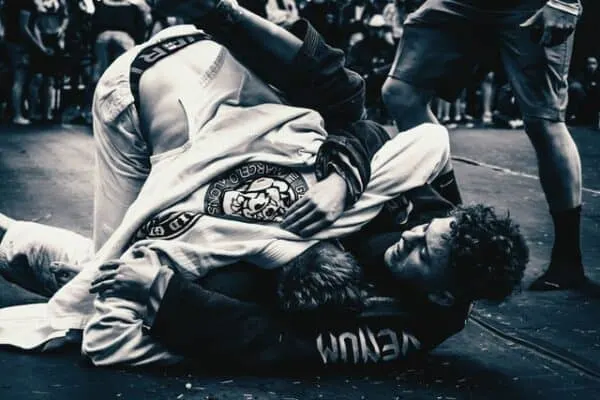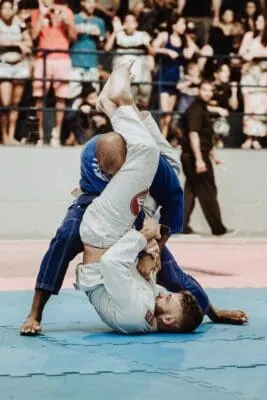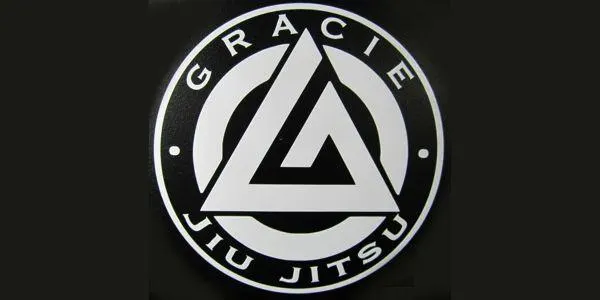
Brazilian Jiu-Jitsu(BJJ) has unequivocally proven by UFC fighters that it’s a very effective martial art inside the UFC octagon. As such many people seek to learn this effective Brazilian art to enhance their self-defense skills outside the octagon, in case they find themselves in an unexpected street fight situation. But is BJJ effective in a street fight?
Brazilian Jiu-Jitsu is effective in a street fight because it allows you to control an attacker without needing to throw strikes, which can be chaotic and dangerous both to the striker and the recipient.
BJJ is no doubt an effective martial art that works in a street fight. But just like any other martial arts, there are things that make it very effective and not so effective in a street fight. Let me explain further why BJJ is effective and has its limitations if you are new to BJJ.
What is Brazilian Jiu-Jitsu(BJJ)?
Brazilian Jiu-Jitsu is a grappling-centered martial art which descends from Japanese Jiu-Jitsu. It came about in the early twentieth century with Japanese Judokas travelled to Brazil and taught a variety of techniques which had been removed from sport Judo.
Since the inception of BJJ, its effectiveness has been demonstrated countless times in mixed martial arts(MMA) and many military and law enforcement organizations practice it all over the world.
BJJ is one of the fastest-growing martial arts in the world, as a result of its use by mixed martial artists, its appearance in films such as John Wick and because of its celebration by popular podcasters such as Joe Rogan and Jocko Willink.
LEARN MORE BJJ vs Japanese Jiu-Jitsu – Key Differences and Similarities
How is BJJ Different From Other Martial Arts?
When we hear the phrase “martial arts”, we often tend to think of stunning spin kicks and breaking boards, commonly seen in Taekwondo and Karate. While these attacks can be devastating when trained over a long period of time, they are arguably too chaotic to be truly practical in a street fight. BJJ is a grappling martial art, which largely involves grabbing an opponent to take them down, then submitting or restraining them there.
BJJ enables a smaller person to defend themselves against a bigger opponent by utilizing techniques that do not require much strength. As a whole BJJ was designed for smaller people to defend themselves by focusing on techniques than relying on brute forces to defeat their opponents.
Brazilian Jiu-Jitsu is designed to be highly practical and is simplistic enough that despite having a steep learning curve can be taught to virtually anyone who invests the time and patience in.
Why Is BJJ Effective In A Street Fight?
Neutralize opponent’s strikings:
BJJ is effective because it allows a practitioner to take their opponent to the ground and control them with various pins and submission holds, such as chokeholds, leg and foot locks and armbars. It encourages a user to get in close to their attacker, as this reduces the distance needed for punches or kicks to gain momentum.
A very few people know how to fight on the ground, Jiu-Jitsu provides the tools to make an assailant feel like they are drowning under pressure.
BJJ can allow a much smaller combatant to restrain, or overcome a larger adversary:
The fact that BJJ techniques can make a BJJ student competent enough to handle larger, stronger opponents can make the art useful for smaller people at risk of physical assault including smaller women by focusing on techniques than strength to defeat their assailants.
Allows you to safely subdue an opponent:
Being able to control someone without striking them also reduces the risk of “one-punch” deaths, which sadly happen quite often in today’s society. If you can hold an attacker down, sap them of their energy until further help arrives, you may be less likely to face legal repercussions of harm caused by strikes, as you will have shown restraint while protecting yourself.
The following video shows a former UFC fighter Matt Serra easily handling an aggressive drunk person by utilizing a BJJ full mount move until police arrive.
BJJ teaches you how to fight on the ground:

BJJ practitioners are also very versed in fighting off of their back, meaning that if they are taken or knocked down, they are more likely to have the skills to hold an opponent, sweep them or generally just prevent them from inflicting more damage. Fights often end up on the ground, so this is a great advantage. BJJ can also be used to get an attacker off of you, so that you can stand up while protecting yourself to make an escape from the situation.
On a side note, it has to be noted that sparring or “rolling” is a very common BJJ training method, which is a way to put into practice some of the techniques in a live, semi-realistic manner. While it almost never involves striking, it is a great way of developing the muscle memory and understanding of balance and coordination.
What Are the Disadvantages of Brazilian Jiu-Jitsu?
Can’t handle multiple attackers:
While being able to go to the ground with one opponent may allow you to control them and greatly reduce the damage they can do, if they have accomplices, you may very quickly find yourself on the receiving end of kicks or stomps to the head and body.
When facing multiple attackers, it is almost always best to try and flee the scene. In this instance, few martial arts will be as effective as a good 400-meter sprint.
BJJ does not teach striking:
A very few BJJ instructors teach striking, or a significant way to defend from strikes, barring ducking and shooting for a single or double leg takedown. There are some instances when a good knowledge of striking will be useful, again, when attempting to stave off multiple attackers.
Who Benefits the Most from BJJ?
As to the question of who benefits from learning BJJ the most, this largely depends on the reasons someone chooses to learn the art. It offers various health benefits such as core strength, cardiovascular exercise and conditioning, alongside its self-defense uses.
From a self-defense aspect, it can be argued that as smaller BJJ students can overcome larger, stronger opponents, smaller people tend to gain the most.
Does Brazilian Jiu-Jitsu Use Any Strikes?
As a general rule, no, there is no striking in BJJ. While it isn’t unheard of for BJJ practitioners to be taught striking, particularly in mixed martial arts gyms, or in gyms with those practicing Combat Jiu-Jitsu (effectively BJJ with open hand strikes), the vast majority of BJJ instructors will put emphasis solely on ground fighting. Striking someone during a sparring session is incredibly frowned upon and it is entirely illegal in competitions.
Is BJJ Hard to Learn?
BJJ is considered fairly difficult to learn – for most people, rolling around grappling with someone may not feel particularly natural to start off and they will need to overcome the barriers presented to themselves by their ego.
BJJ requires a significant time investment to see results. When starting off, it may take training 2-3 times a week for about six months before a student is competent enough to defend themselves.
LEARN MORE Still curious? Click here to find out Is BJJ Hard To Learn? A Guide For Beginners
Which is More Effective Gracie Jiu-Jitsu or BJJ?

As a general rule, Gracie Jiu-Jitsu focuses more on self defense than Brazilian Jiu-Jitsu. BJJ, on the other hand, is designed more for the sport of grappling. Therefore, Gracie Jiu-Jitsu is arguably more effective when it comes to self-defense.
When you learn Gracie Jiu-Jitsu, instructors will teach you passed down knowledge from the Gracie “lineage”. Helio Gracie was one of the progenitors of the art, having being taught various techniques by the Japanese Jiu-Jitsu/Judo artist, Maeda.
For self-defense purposes, it is worth studying “the Gracie combatives” – an instructional DVD which teaches 36 “essential” lessons which were originally developed for the US Army but can be used for street defense.
LEARN MORE Get the full report on What’s the Difference Between Gracie Jiu-Jitsu and BJJ?
Related Questions
BJJ vs Krav Maga: Which is Better for Self-Defense?
Krav Maga is the art used by the Israeli military forces and was originally designed by boxer, martial artist and sportsman, Imi Lichtenfeld for oppressed Jews to protect themselves from physical attacks in Eastern Europe during the 1930s. In some ways, it is similar to Bruce Lee’s Jeet Kune Do, a system which was primarily about using what works for each individual, on their own terms.
Krav Maga borrows techniques from many different martial arts, including Wing Chun, Muay Thai and on occasion, even BJJ.
Like Jeet Kune Do, some would argue that Krav is more of a “mentality” or a “system” than a martial art on its own. The teaching of this system can wildly vary in quality, due to a certain amount of commercialization of the art. It tends to favor “extreme” attacks – eye gouges, throat shots and palm-heel strikes, which can be deadly but they are difficult to train in a sparring scenario, as this would be too dangerous for a training partner on the receiving end of these attacks. This makes some of the training more conceptual than practical and relying on these techniques when the fight or flight reaction kicks in may not be a good idea.
If you are able to learn Krav Maga effectively, then it can be very good for handling multiple assailants and making a getaway. However it should be noted that unlike BJJ which can be used to restrain someone in a controlled manner, Krav Maga’s attacks may land you in a lot of legal trouble as they are designed for warfare.
BJJ vs Wrestling: Which is Better for Self-Defense?
Wrestling is a fairly-broad umbrella term for various forms of sport grappling found all over the world. Almost all cultures have their own grappling arts, but perhaps the most widely practiced versions are Greco-Roman, freestyle and catch wrestling. Like BJJ, most wrestling forms can be used to close the distance and restrain an opponent, but there are a number of key differences.
Firstly, sport wrestling is much more concerned with pinning and holding an opponent down than submitting them with joint locks or chokeholds. This means that there is an arsenal of weapons which the wrestler tends to lose out on.
Secondly, BJJ coaches tend to focus a lot more on what happens after the fight has gone to the ground, than the standing grappling, or takedown game. This can sometimes be a hindrance as you may still be in danger of being on the receiving end of strikes. Wrestlers are generally more effective at taking their opponent to the ground. On the flip side of this, wrestlers don’t spend a great deal of time learning how to fight off of their backs, or utilize the various useful guard positions which BJJ practitioners do.
It should be noted that the focus on conditioning which wrestlers have can be fantastic for having the endurance and toughness required to survive the most dangerous of scenarios.
BJJ vs Judo: Which is Better for Self-Defense?
While both arts judo and BJJ are grappling focused, Judo is much more centered on standing and throwing an opponent, while BJJ tends to focus on newaza (or ground fighting).
Both Judo and BJJ have their pros and cons – much like wrestlers, judokas will find it much easier to take their assailants to the ground than those practicing BJJ. Using throws, judokas can essentially strike their opponent with the ground itself in order to stun, or injure their combatant. This can allow them to follow up and restrain their opponent, or simply make a get-away. However, again, like wrestling judo doesn’t offer the martial artist the skills to protect themselves while they are on their back.
Judokas are generally much more prone to injury, however. In live sparring, BJJ students will “tap out” or submit when they are at risk of having a bone broken, ligaments torn, or falling unconscious but live sparring for judokas involves throwing opponents. Throwing people can put a significant amount of stress on hips, knees and back, which can add up over time. For the average person, it may make more sense to train BJJ, which might have its own risks is less likely to cause as much long-term stress on the body.
LEARN MORE Check out our extensive BJJ vs Judo – Key Differences and Core Similarities
Which Martial Art Is Most Effective for Self-Defense?
It is difficult to say what the most effective martial art for self-defense is, but there are a number of skills and attributes that anyone should aim to improve. Sharpening your sense of awareness to detect when situations could be dangerous, how to de-escalate these situations or make a getaway is a great thing to do. Additionally, as mentioned previously, being a good runner can get you away from attackers, if it is required.
When it comes to attacking, or defending, knowing how to grapple is obviously very useful, so Brazilian Jiu-Jitsu can be a great art, however understanding footwork, timing and how to defend yourself from strikes can be vital. For this reason, studying boxing can be a great idea. Boxing provides a good understanding of how to guard your head, how to use parries, blocks, slips and rolls to deflect or avoid being punched and can help you close the distance on an attacker should you need to. Studying both arts can be a great idea, as you should have an advantage over an untrained attacker, either on the feet, or on the ground.
What Is the Least Effective Martial Art?
It is also difficult to say what the least effective art for self-defense is. An argument could be made that some traditional martial arts, designed for different times may no longer be relevant. Aikido techniques are often found to be impractical by today’s standard, while Kendo, Iado or the various European Medieval Martial Arts may no longer have much use, given that carrying a sword or other weapon of antiquity on our person may be at the very least frowned upon.
Tai Chi, or Qi Gong may also be great tools for sharpening the mind, meditating or relaxing but applying them to a street combat scenario may not be the best idea.
It should be noted that not every martial art has to be entirely designed for self-defense. Some are great for sport, while some are fun, interesting or relaxing.
